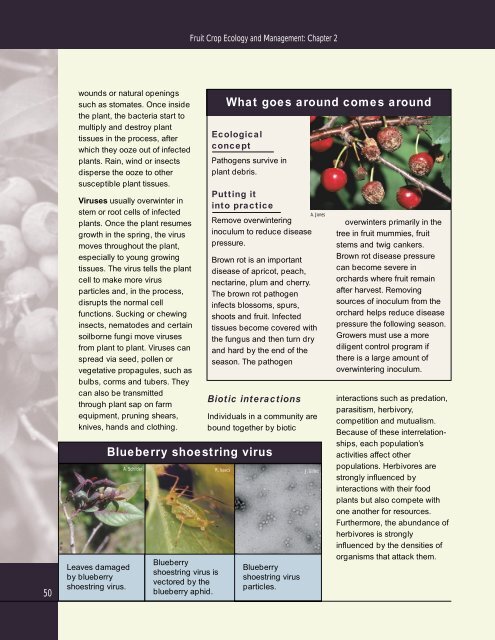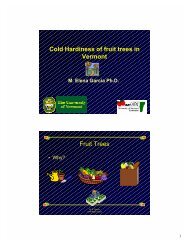Fruit Crop Ecology and Management - UVM Apple Orchard
Fruit Crop Ecology and Management - UVM Apple Orchard
Fruit Crop Ecology and Management - UVM Apple Orchard
You also want an ePaper? Increase the reach of your titles
YUMPU automatically turns print PDFs into web optimized ePapers that Google loves.
50<br />
wounds or natural openings<br />
such as stomates. Once inside<br />
the plant, the bacteria start to<br />
multiply <strong>and</strong> destroy plant<br />
tissues in the process, after<br />
which they ooze out of infected<br />
plants. Rain, wind or insects<br />
disperse the ooze to other<br />
susceptible plant tissues.<br />
Viruses usually overwinter in<br />
stem or root cells of infected<br />
plants. Once the plant resumes<br />
growth in the spring, the virus<br />
moves throughout the plant,<br />
especially to young growing<br />
tissues. The virus tells the plant<br />
cell to make more virus<br />
particles <strong>and</strong>, in the process,<br />
disrupts the normal cell<br />
functions. Sucking or chewing<br />
insects, nematodes <strong>and</strong> certain<br />
soilborne fungi move viruses<br />
from plant to plant. Viruses can<br />
spread via seed, pollen or<br />
vegetative propagules, such as<br />
bulbs, corms <strong>and</strong> tubers. They<br />
can also be transmitted<br />
through plant sap on farm<br />
equipment, pruning shears,<br />
knives, h<strong>and</strong>s <strong>and</strong> clothing.<br />
Leaves damaged<br />
by blueberry<br />
shoestring virus.<br />
<strong>Fruit</strong> <strong>Crop</strong> <strong>Ecology</strong> <strong>and</strong> <strong>Management</strong>: Chapter 2<br />
Ecological<br />
concept<br />
Pathogens survive in<br />
plant debris.<br />
Putting it<br />
into practice<br />
Remove overwintering<br />
inoculum to reduce disease<br />
pressure.<br />
Brown rot is an important<br />
disease of apricot, peach,<br />
nectarine, plum <strong>and</strong> cherry.<br />
The brown rot pathogen<br />
infects blossoms, spurs,<br />
shoots <strong>and</strong> fruit. Infected<br />
tissues become covered with<br />
the fungus <strong>and</strong> then turn dry<br />
<strong>and</strong> hard by the end of the<br />
season. The pathogen<br />
Biotic interactions<br />
Individuals in a community are<br />
bound together by biotic<br />
Blueberry shoestring virus<br />
A. Schilder R. Isaacs J. Gillett<br />
Blueberry<br />
shoestring virus is<br />
vectored by the<br />
blueberry aphid.<br />
What goes around comes around<br />
Blueberry<br />
shoestring virus<br />
particles.<br />
A. Jones<br />
overwinters primarily in the<br />
tree in fruit mummies, fruit<br />
stems <strong>and</strong> twig cankers.<br />
Brown rot disease pressure<br />
can become severe in<br />
orchards where fruit remain<br />
after harvest. Removing<br />
sources of inoculum from the<br />
orchard helps reduce disease<br />
pressure the following season.<br />
Growers must use a more<br />
diligent control program if<br />
there is a large amount of<br />
overwintering inoculum.<br />
interactions such as predation,<br />
parasitism, herbivory,<br />
competition <strong>and</strong> mutualism.<br />
Because of these interrelationships,<br />
each population’s<br />
activities affect other<br />
populations. Herbivores are<br />
strongly influenced by<br />
interactions with their food<br />
plants but also compete with<br />
one another for resources.<br />
Furthermore, the abundance of<br />
herbivores is strongly<br />
influenced by the densities of<br />
organisms that attack them.



